10 CPG Marketing Trends & Examples to Inspire Your Tactics in 2023
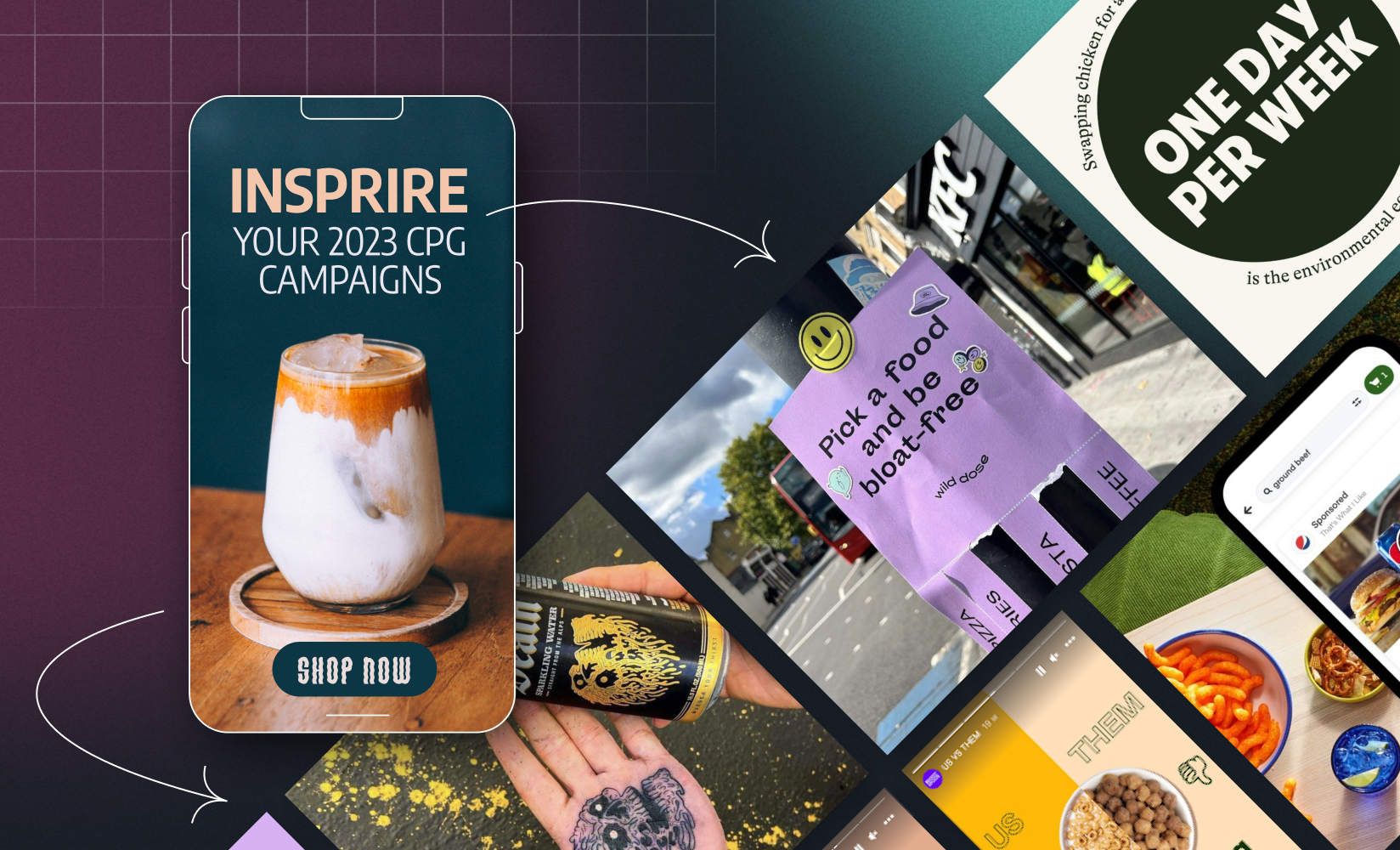
Facebook advertising, TikTok videos, influencer marketing—maybe you’ve tried these, but nothing’s moving the needle for your scaling consumer packaged goods (CPG) brand.
Well, it takes a strong marketing mix to stand out from brands claiming their share of the $20 million CPG industry.
Whether you drive online sales for a fancy beverage or home essentials, your products, paid media, content, and more, need to demand attention.
The only problem?
The CPG industry moves fast, and food and consumer packaged goods marketing is tougher (it’s a competitive, creative space). The older or more common tactics you’ve seen in the wild may not help you scale.
The older playbooks are…played out.
So, in this post, we’ll help you get a jump start on leveraging CPG food and beverage ecommerce trends and planning out your 2023 strategy.
We’ll get into:
The state of CPG marketing
If you’re a CPG marketer on an ecommerce team, you know that this industry’s only growing. The market will hit a $3.6 billion valuation in 2022. And is set to tip $7.3 billion by 2032.
The problem? Everything is getting more expensive.
- Inflation is up 8.2% year over year, and manufacturing and shipping costs have increased dramatically.
- This has a domino effect on consumer prices—the prices of everyday CPG products have risen 3.2% over the past year.
Despite inflation and soaring customer acquisition costs, CPG marketers also have mounting pressure on their shoulders. Almost 80% of CEOs are looking to their marketing leaders to drive revenue growth, forcing CPG marketing teams to try, test, and innovate.
Data is fundamental to overcome these obstacles. McKinsey reports CPG brands that do data-driven marketing at scale well can increase net sales value by up to 5%.
In one case study, a food retailer improved its return on ad spend by 40% using first-party data to model its best-known customers.
#cta-visual-pb#<cta-title>Design beautiful pages for your store<cta-title>Easily create product pages, collection pages, and more with Shogun Page Builder.Start designing for free
What are the most effective CPG marketing channels?
Because each brand is different, the most effective CPG marketing channels are those that help you to build long-term relationships with your customers. This can include:
- Loyalty programs
- TV advertising
- Online communities in Facebook Groups, Slack channels, or owned webpages
- Email marketing—the only direct line of communication you have with shoppers
Notably, social media is a tough one to navigate.
Big platforms like Facebook and Instagram have moved towards the pay-to-play model. Organic reach is down; the only way to reach the audience you’ve built on those social networks is to pay for it.
This is a race to the bottom, which can soak up a huge portion of your profits.
According to DataReportal, the average CPM for a social media campaign was up a staggering $9.13 in Q4 2021—up from $6.17 at the start of 2021.
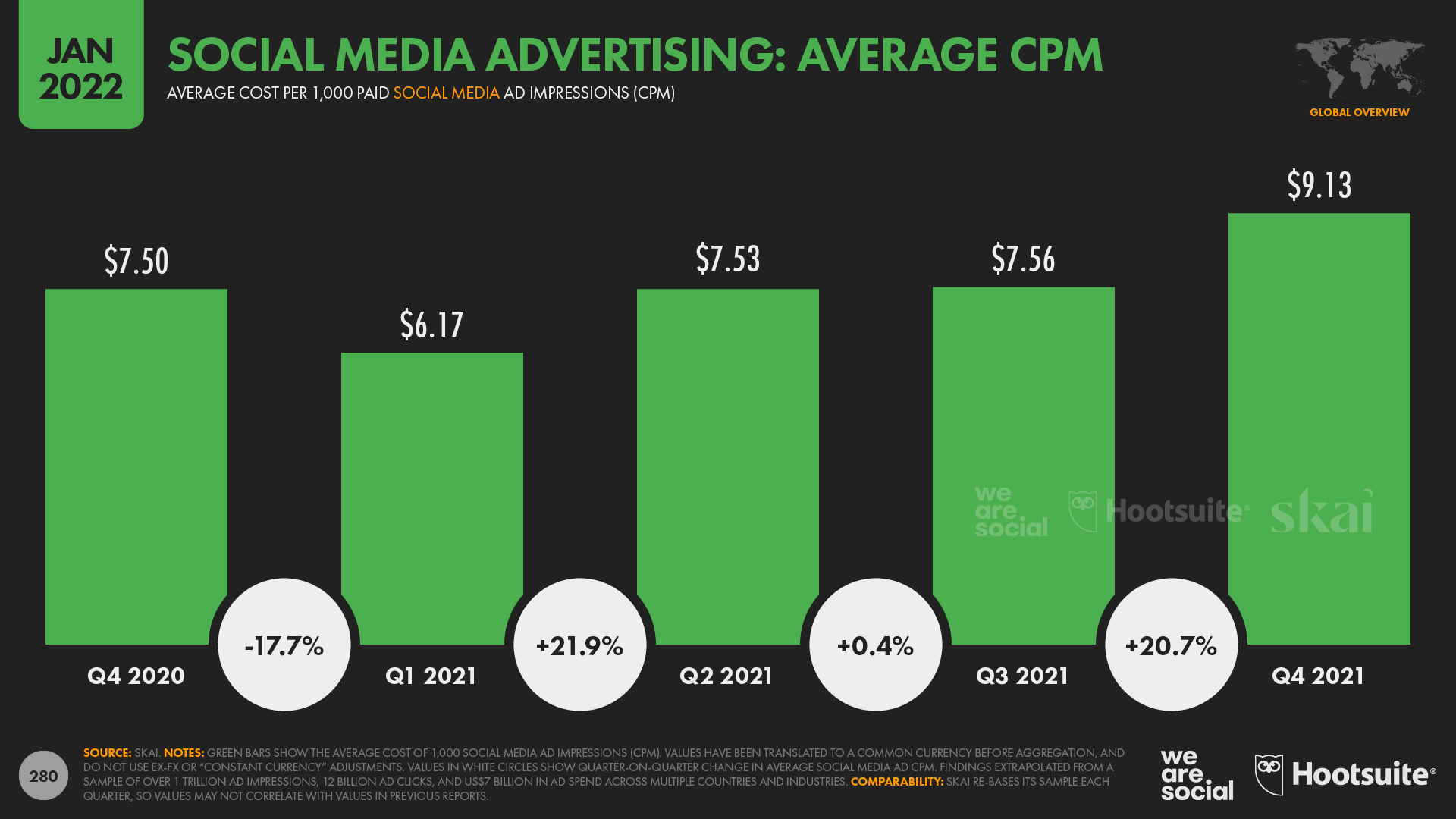
How much do CPG companies spend on marketing?
With it being such a competitive and fast-moving space, it’s perhaps no surprise that marketers in the CPG industry spend the highest share of overall budget on digital marketing.
Let’s take a look at how those figures play out across each channel:
- The average CPG brand increased their marketing spend by 18.3% over the last year, with 55% planning another budget increase
- CPG brands spend $38.83 billion on digital advertising each year
- On-site search ads claim the most of a CPG brand’s advertising budget
- Some 64% of CPG brands will increase their retail media spending in 2023.
Considerations for shaping your CPG marketing strategy
Brands that sell consumer-packaged goods often need to think differently about their marketing tactics and execution than traditional online retailers.
- Strong branding rarely influences first-time customers. It’s been found that only 8% of consumers list brand names as the trigger for a CPG purchase. Unlike traditional retailers, CPG marketers need to heavily market their brand’s core values, showcase trust signals, and build community to entice first-time shoppers to convert.
- CPGs sell fast. CPG are typically perishable (like skincare products or food items), which means turnaround times are especially fast. CPG marketers need to work closely with supply chain executives to ensure stockouts don’t turn potential customers away. Ultimately, marketers in CPG need to time their campaigns and promotions around stock available and monitor especially closely.
- Repeat purchases are the norm. CPG are essential items that consumers tend to replace. Examples include toothpaste, cleaning products, and groceries. They run out; consumers make a repeat purchase to replenish their own supply. CPG marketers need to focus on retention (and maybe even subscription models) to ensure customers restock suppliers from their store, instead of a competitor’s.
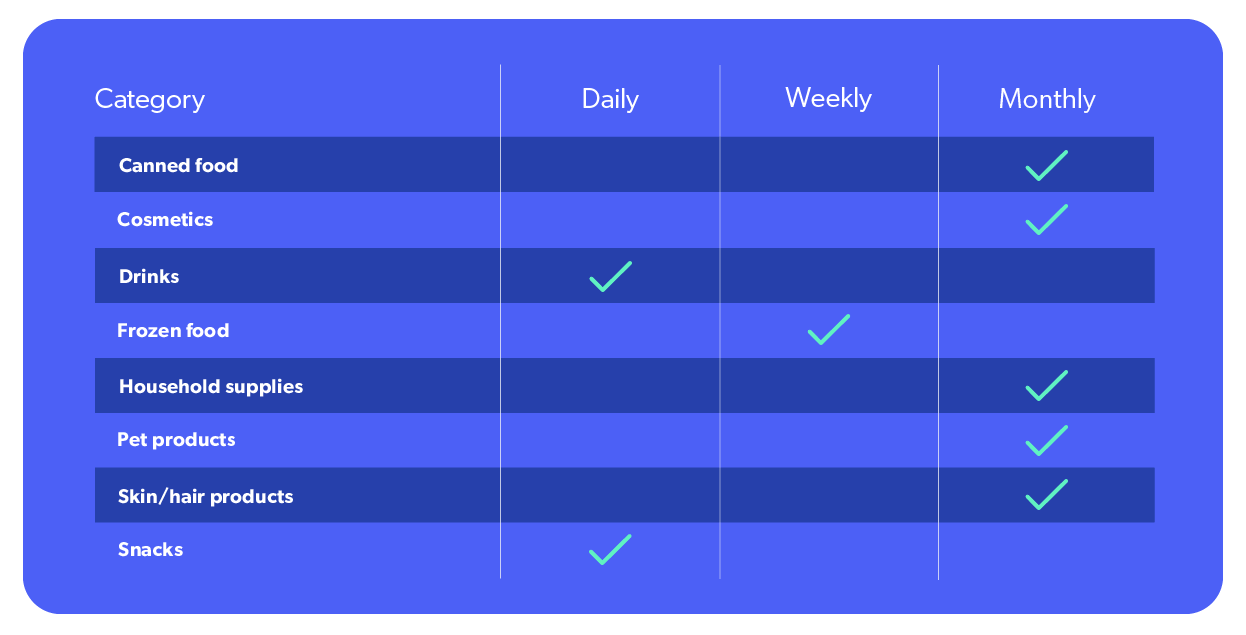
7 CPG ecommerce marketing trends to try for 2023
Considering what drives consumers to buy CPG, below are some CPG ecommerce marketing trends we’re seeing in this space and how they can influence your marketing mix and tactics in the coming year:
- Focus on health with smaller portioned packs
- Actively prioritize sustainability
- Try limited release drops
- Use quizzes to gather zero-party data
- Go offline with experiential retail
- Use delivery apps as a distribution channel
- Get expert endorsed—not just creator
1. Focus on health with smaller portioned packs
Not all customers want more product for less money.
In fact, this can be especially true if a target customer segment is health-conscious and doesn’t care to demolish an entire packet of goodies.
In fact, Mcdonald’s was one of the first brands to focus on a less-is-more approach when it released ‘Mini McFlurries’—smaller versions of its signature soft whip ice cream—back in 2018.
Other CPG brands followed suit, including Oreo (or Mondelez International) with their line of on-the-go cookies and Ritz’s ‘25g cracker packs’.
Smaller portion packs (and the way they’re marketed as ‘on-the-go’ or more health-conscious in subsequent messaging) aren’t a CPG marketing trend set to die down any time soon.
Alongside possible health benefits for customers, smaller portion packs help CPG brands increase profit margins amid inflation.
Creating a small portion pack that’s half its usual size doesn’t mean it should retail at a 50% markdown. Using the Mcdonald’s example: there’s only a $0.60 difference between full-size and mini McFlurries.
Moreover, smaller portion sizes of CPG products alleviate demand for raw materials since you’re using less of them.
Take wheat, for example—a key ingredient in many food products. The price of wheat is up 64% since last year. You can use less of it while still appealing to customers with portion packets and marketing these in clever ways.
As an example of the marketing that can come from this trend, Danone, the umbrella company behind CPG brand Activia, uses its on-the-go yogurts as the foundation for its influencer marketing campaigns.
TikTok creator Kristie Sita created this short video that discusses a healthy lifestyle, featuring Activia’s ‘on-the-go’ probiotic yogurts.

#cta-visual-pb#<cta-title>Build an exceptional CPG brand online<cta-title>See how Page Builder can take your ecommerce experience to the next level. Start building for free
2. Actively prioritize marketing your sustainability efforts
Sustainability was once a buzzword—a way for CPG brands to market to customers through a tactic known as “greenwashing.”
But modern shoppers can see straight through greenwashing brands. They’re voting with their wallets, actively choosing to shop with brands that are better for the planet…and shunning those that aren’t.
Not convinced? Research by Bazaarvoice found:
- 77% of consumers think it’s important for CPG brands to source their products responsibly.
- 76% of consumers said it is important for them to see evidence of CPG brands’ initiatives to reduce their carbon footprint.
- 68% of consumers say it’s important that ingredients in the cleaning products they buy are natural and/or eco-friendly.
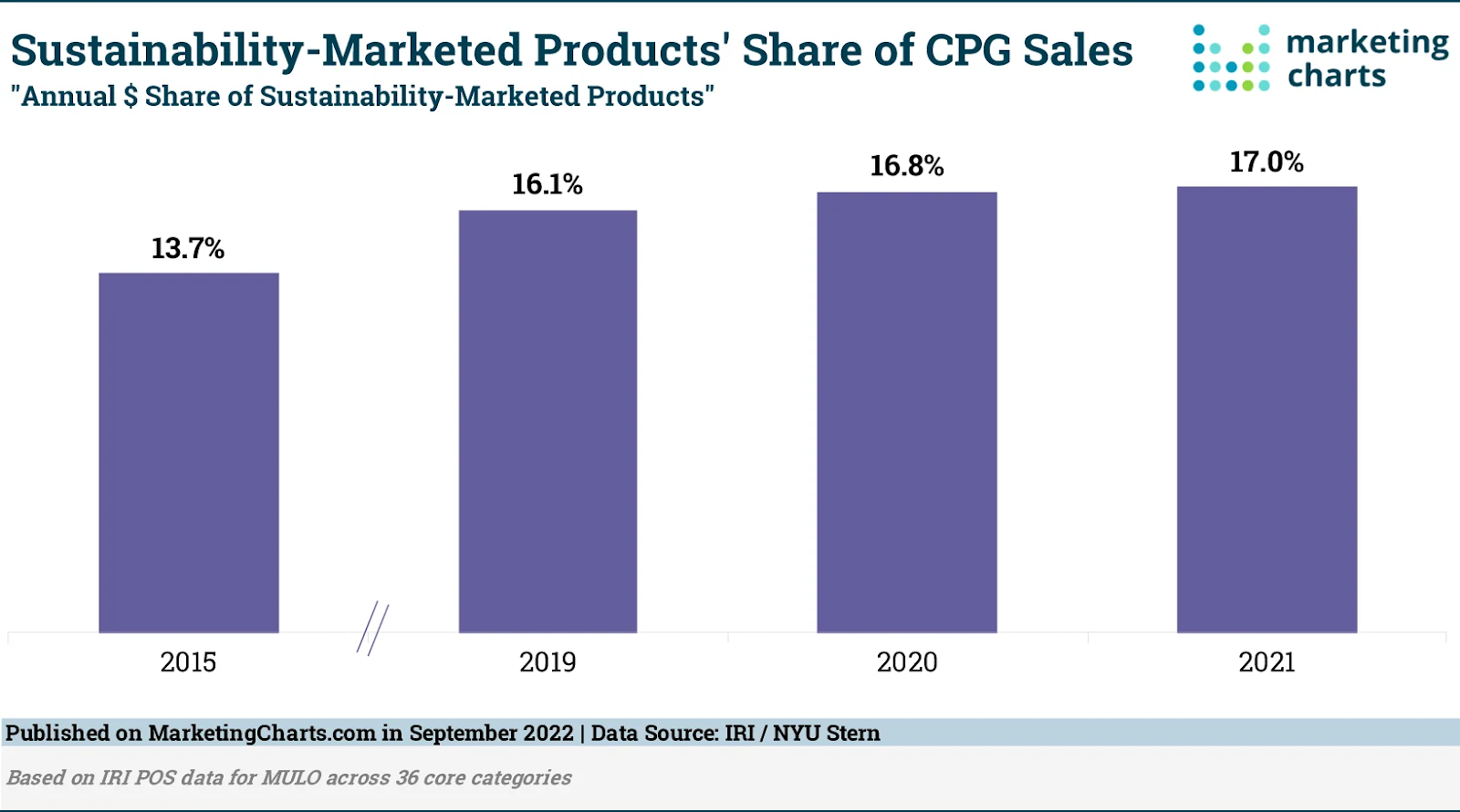
According to Michael Bell, Founder and CEO of Manukora: “Sustainability is becoming crucial for CPG brands. Consumers are willing to pay more for environmentally friendly products.”
“To compete, you must emphasize what you’re doing for the environment,” Michael says. “Companies are highlighting their sustainability in their packaging, manufacturing, and supply chain as a whole. It’s also important to give back. In CPG brands’ marketing efforts, explain how [you’re] helping the environment around [you].”
Daring Foods is a prime example of this.
The CPG brand continually reinforces the fact its plant-based protein products are better for the environment than traditional chicken—like this tweet:
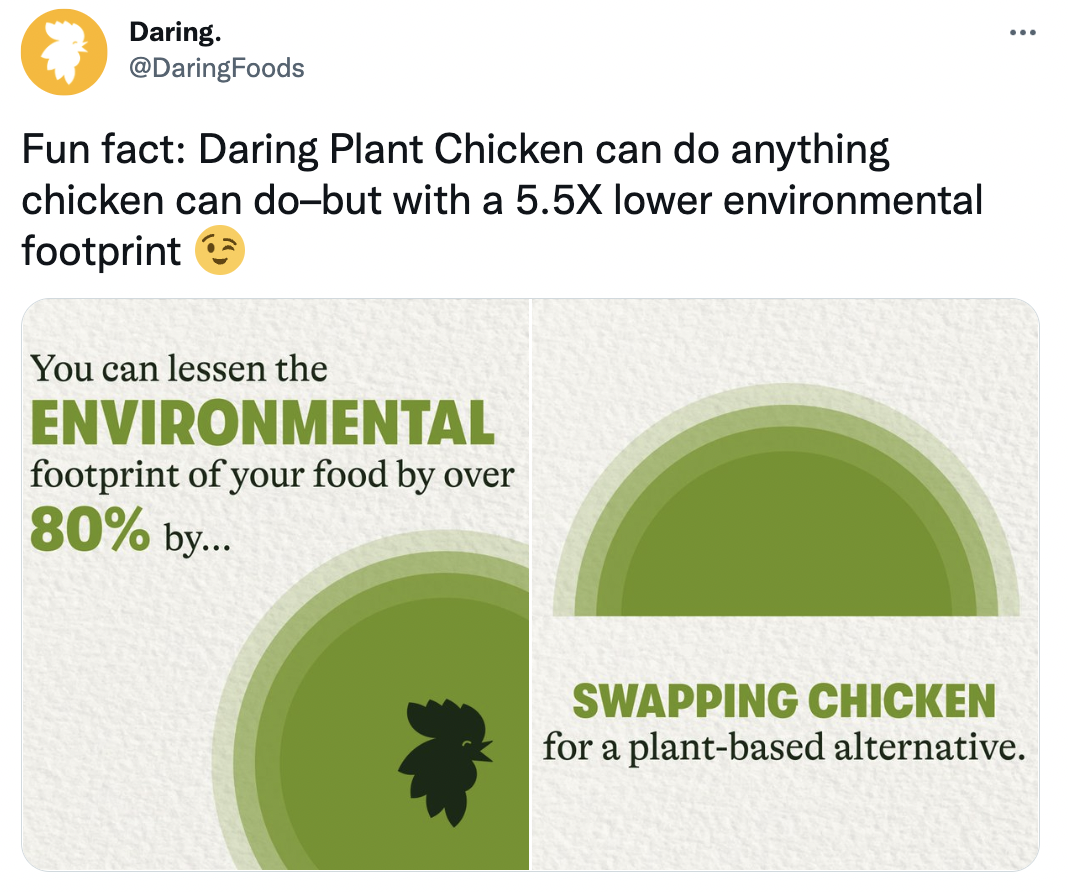
…and this Instagram post, which explains how swapping to a plant-based alternative (like Daring Foods’ products) can save over 2.4 million showers worth of water, and remove the emissions of over 239K cars:
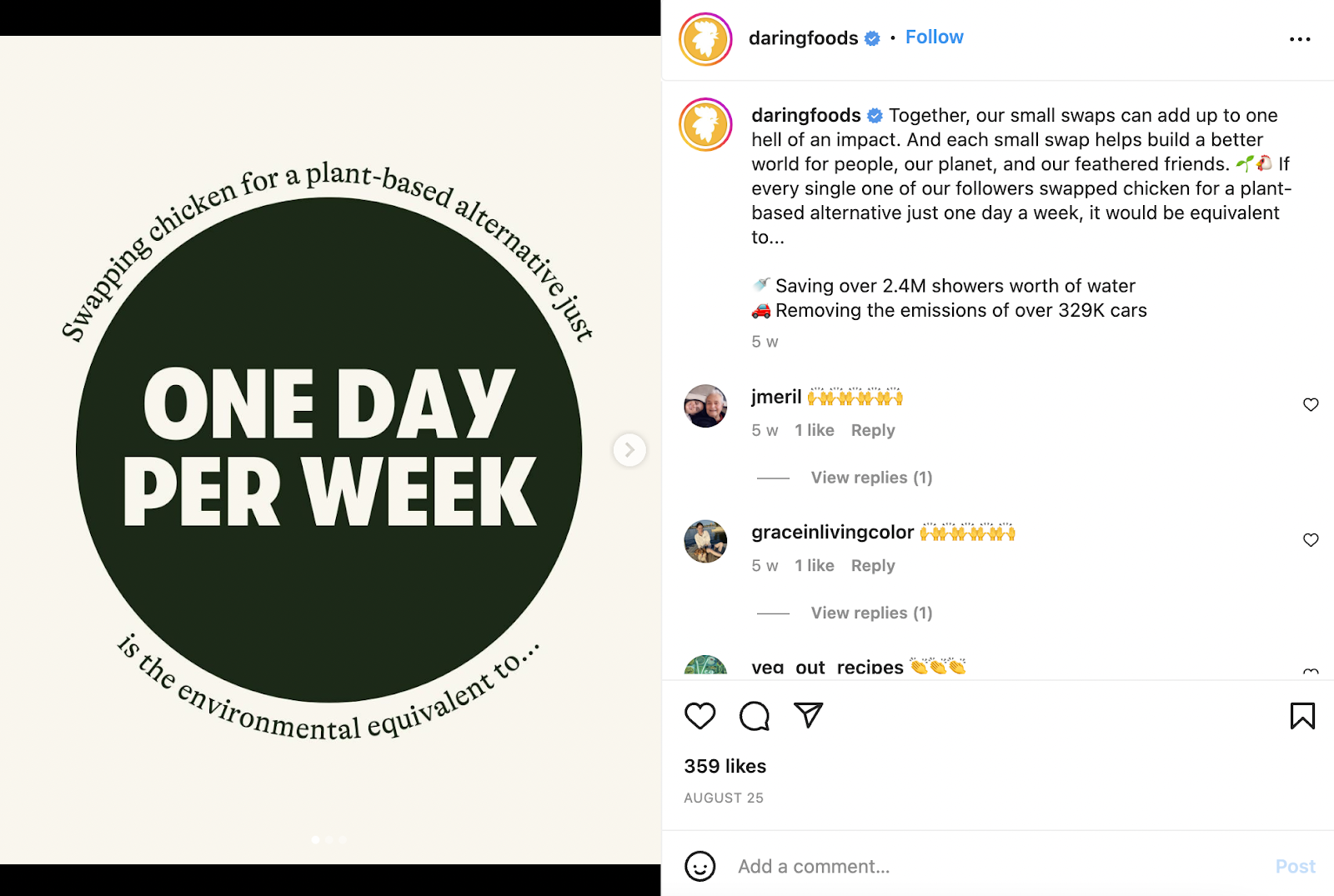
3. Try out limited-release drops
Managing inventory is one of the hardest things about operating a CPG brand.
That’s especially true for marketers who have to carefully balance marketing strategies with inventory levels.
The last thing customers want to see after they’re excited to purchase is an “out of stock” message.
Modern Retail found the number of brands launching limited-release products increased by 12% since last year.
Now, more than half of all retailers include limited-inventory drops as part of their strategy, with 40% of brands doing so with the main aim of driving consumers into a frenzy.
Limited-release drops work for two reasons:
- They build a feeling of exclusivity and urgency. Potential customers have to act now to secure their products.
- They help CPG brands manage supply chain issues. If a supplier is running low or manufacturing delays prevent a continuous supply of stock, customers are already aware that they may not get a chance to buy.
Grenade is one CPG brand putting this trend into action. Its core product is protein bars, though it recently announced to email subscribers the return of its apparel. Subscribers were prompted to act now to secure their t-shirts.
The brand purposely ordered limited quantities so its CPG marketing team could create a sense of urgency.
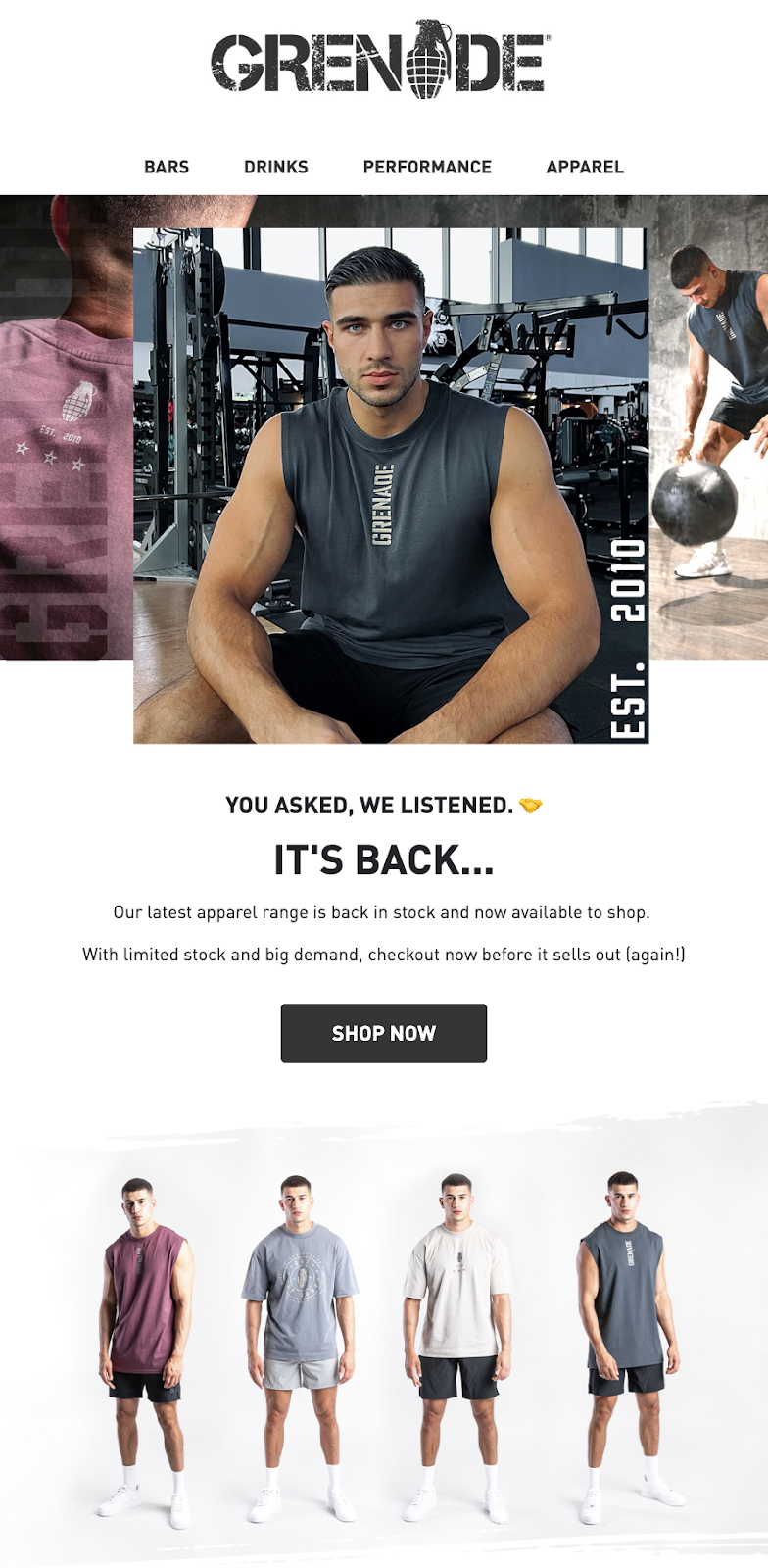
4. Run helpful quizzes to gather zero-party data
Google announced that by the end of 2024, its Chrome browser will prevent marketers from using cookie data to track consumer activity online.
However, to combat this lack of tracking/data—quizzes, polls, and surveys are superb ways to extract zero-party data from your customers.
You can use tools like OctaneAI to draw answers from your potential customers and deliver personalized solutions to their problems.
Take this quiz from Function of Beauty. The CPG brand sells hair care products through its online store.
There are hundreds of reasons someone would buy them. Instead of zoning on one reason it thinks its audience would relate to, it asks visitors to explain what they’re looking for:

Potential customers choose:
- the type of hair they have
- their main goal for their next purchase, and
- the fragrance they’d prefer.
The final stage of the quiz is a prepopulated online cart, complete with personalized product recommendations based on their answers.
This personalized approach to CPG marketing not only helps customers discover the product they want, but it helps you collect consumer data for future retargeting and marketing campaigns.
In Function of Beauty’s case: If a customer says “dry hair” is their biggest hair problem, the CPG brand could opt them into an email marketing campaign all about overcoming dryness.
Over the next week, they’ll receive a series of emails that educates them on why their hair might be dry and how your product solves it.
#cta-visual-pb#<cta-title>Grow your Shopify store quickly<cta-title>With Shogun Page Builder, you can get a jump on the competition and create a store that stands out.Start building for free
5. Go offline with experiential retail
Physical retail suffered throughout the pandemic. But now that lockdowns have lifted and consumers no longer have to default to making CPG purchases online, experiential retail is making a comeback.
In fact, one-third of consumers are likely to engage with in-store experiences, such as workshops, pop-up shops, or classes. It’s why 40% of brands say experiential retail is a top priority over the coming year.
Take it from Jeremy Schmidt, co-founder of Blossom Wellness, who says the CPG brand has had the most success with in-person events like farmer’s markets:
“It’s harder to re-create brand experience online, so we’ve spent our early stages building our brand in person and gathering content that we can share online so people online can get a feel for what the experience with our product is like in person.”
The best part?
Experiential retail doesn’t have to mean a $10,000+ investment in a new brick-and-mortar store, nor a commitment to attending regular markets or events.
It could be as simple as interactive billboard campaigns in a hotspot for your customers like CPG brand Wild Dose does with its tearable advertisements:

6. Use delivery apps as a distribution channel
The pandemic paved the way for consumers to get products from their favorite CPG brands via contactless delivery.
Apps like GoPuff, Instacart, and DoorDash each reported major increases to their user bases, with the average session on a food delivery app lasting 17 minutes.
These channels are no longer just delivery providers for customers who want products now, without leaving their homes. They’re valuable distribution channels for your CPG marketing.
Take the CPG brand Recess, which sells CBD-infused beverages. The retailer lists products for sale on delivery apps like Gopuff. Its founder and CEO, Benjamin Witte, told Modern Retail the goal is to make its products available to buy everywhere: “Just being on there and getting eyeballs is a great form of marketing for us.”
Aside from being in a potential customers’ line of sight when searching delivery apps for CPG, Gopuff has included Recess’ drinks in special bundles—like a movie night snack pack.
It’s a CPG marketing strategy that contributes to 50% of Recess’ overall revenue.
To take this trend one step further, consider running shoppable video ads on these home delivery channels for food and beverage marketing.
Brands in the CPG sector spend over $30 billion each year on digital advertising—70% of which is devoted to reaching potential customers who shop via mobile.
Instacart, for example, allows CPG brands to pay to reach its user base.
Consumers searching for “ground beef” see a sponsored campaign by PepsiCo, which highlights how its drinks pair excellently with the burgers they’re looking for.
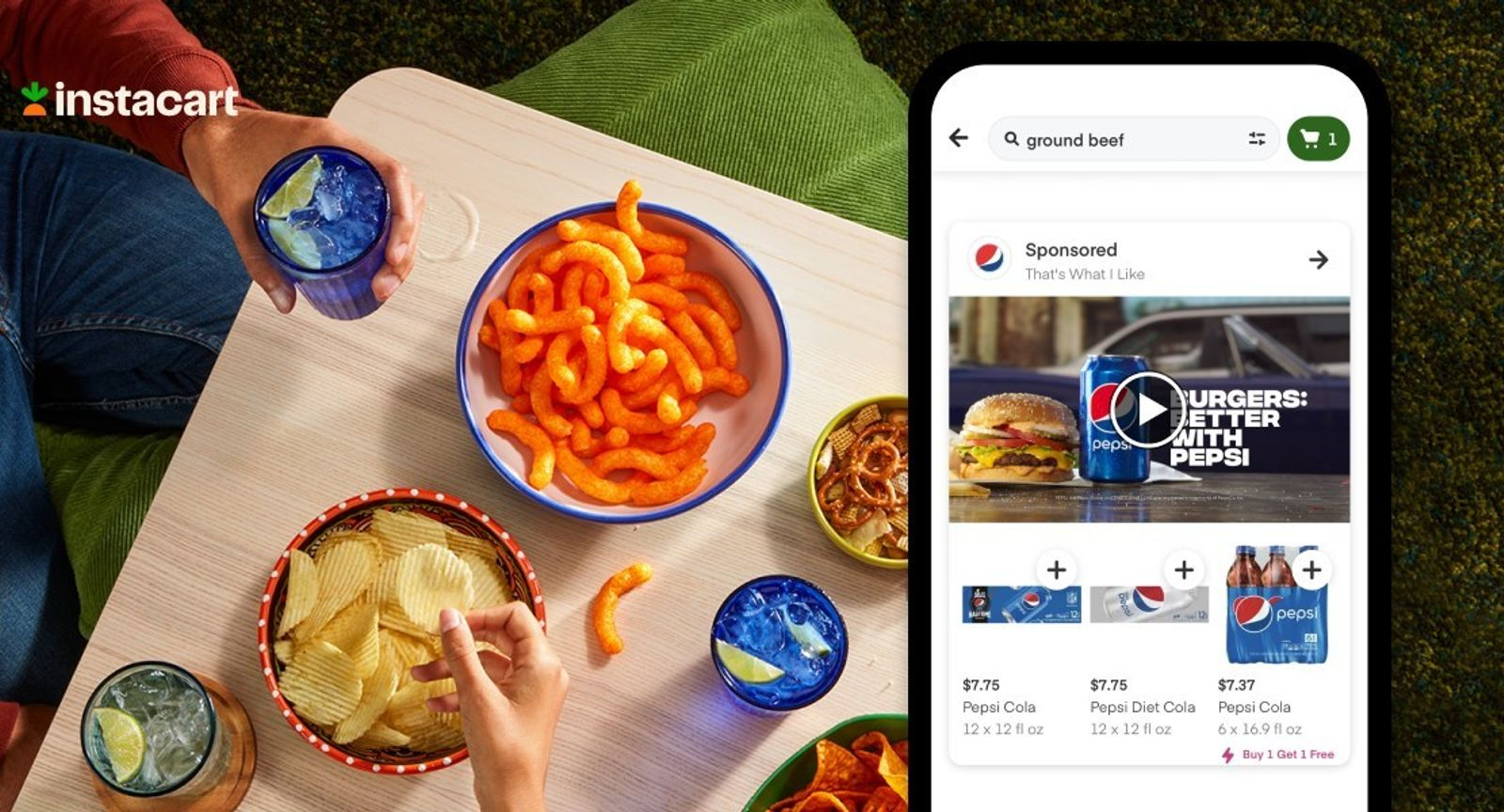
7. Get expert-endorsed—not just creator
Creators are the latest iteration of the influencer marketing world. Instead of partnering with mega influencers with millions of followers, the rise of platforms like TikTok means anyone can become a creator.
Interestingly, creator endorsements aren’t as effective as other CPG marketing strategies. MarketingCharts found that CPG brands endorsed by celebrities or influencers ranked as the least important factor that influences their purchase decisions.
Safe, organic, and high-quality products were more important—three elements which expert endorsements help to prove.

The fact that everyone can now be an influencer means consumers are untrusting of social media ads they see.
Does the creator truly like the product, or have they simply been paid to promote it?
You can remove the risk of biased opinions from impacting your CPG marketing strategy by sourcing endorsements from experts, such as those with professional qualifications in your field.
Everyday Chews is a brand putting this CPG marketing trend into play. People browsing its product page see that Everyday’s dog supplements are veterinarian-recommended.
This info is featured both in the main product description and the banner of trust signals below it.


The best consumer packaged goods marketing examples
The CPG industry is packed with innovative examples of cool CPG marketing tactics to try. Let’s break down three brands that are producing exceptional CPG marketing campaigns—and reaping the rewards.
1. Magic Spoon
Magic Spoon took a conventionally boring product—cereal—and built a brand that’s rapidly claiming its share of a $36.5 billion breakfast cereals market.
Part of Magic Spoon’s success lies within its CPG marketing strategy, which focuses heavily on comparisons against brands their target market is familiar with.
This messaging starts on third-party social marketing channels like Instagram.
Magic Spoon has an Instagram Stories highlight titled “Us vs. Them,” where it compares the protein and carb makeup of its cereal versus popular competitors.
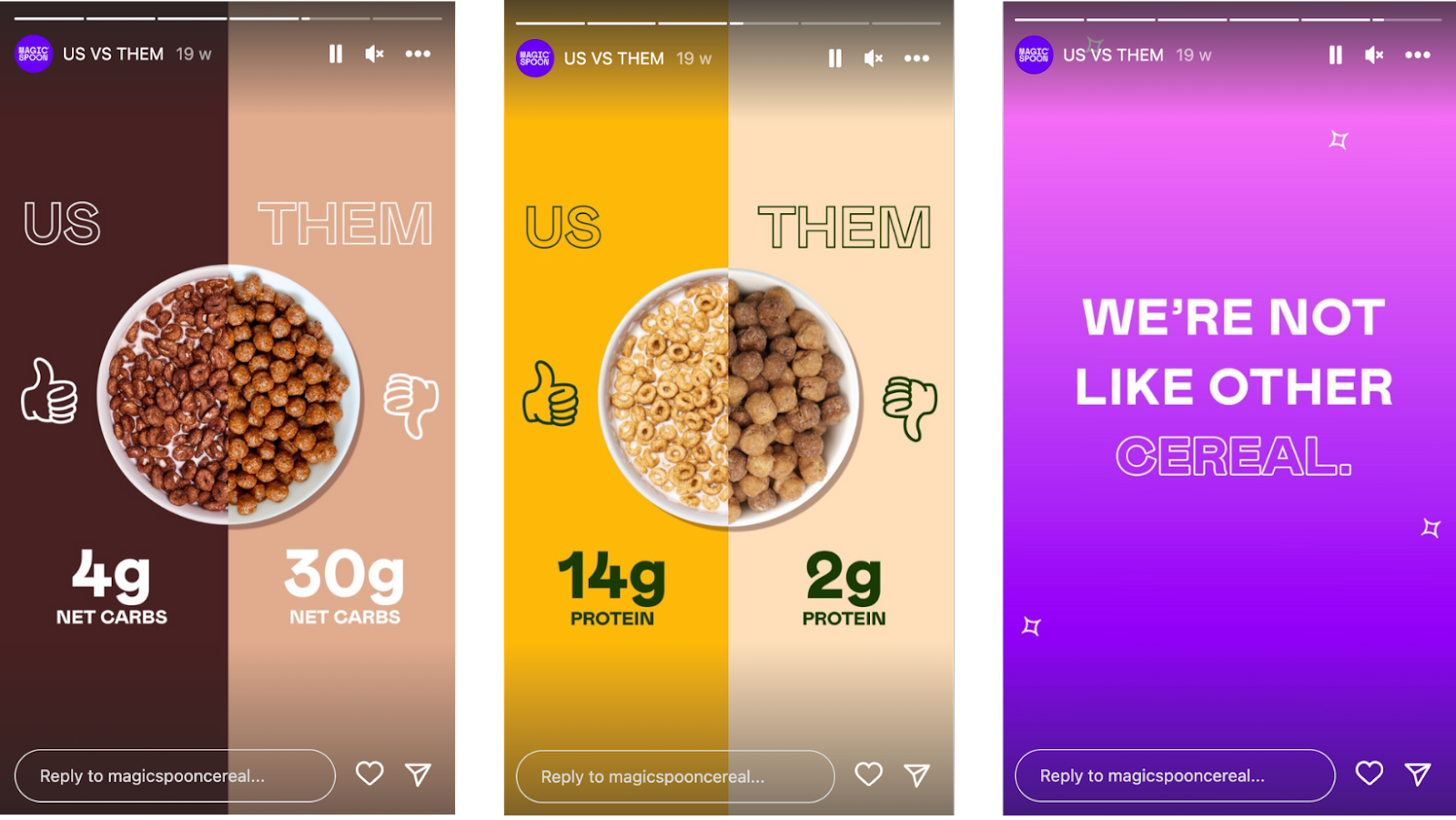
Once leaving a social media platform to learn more, website visitors see a table that compares Magic Spoon cereal against well-known brands like Froot Loops, Reese’s Puffs, and Frosted Flakes.
Magic Spoon comes out top for things it knows its Millennial audience cares about, including the amount of protein, net carbs, and sugar in the product.
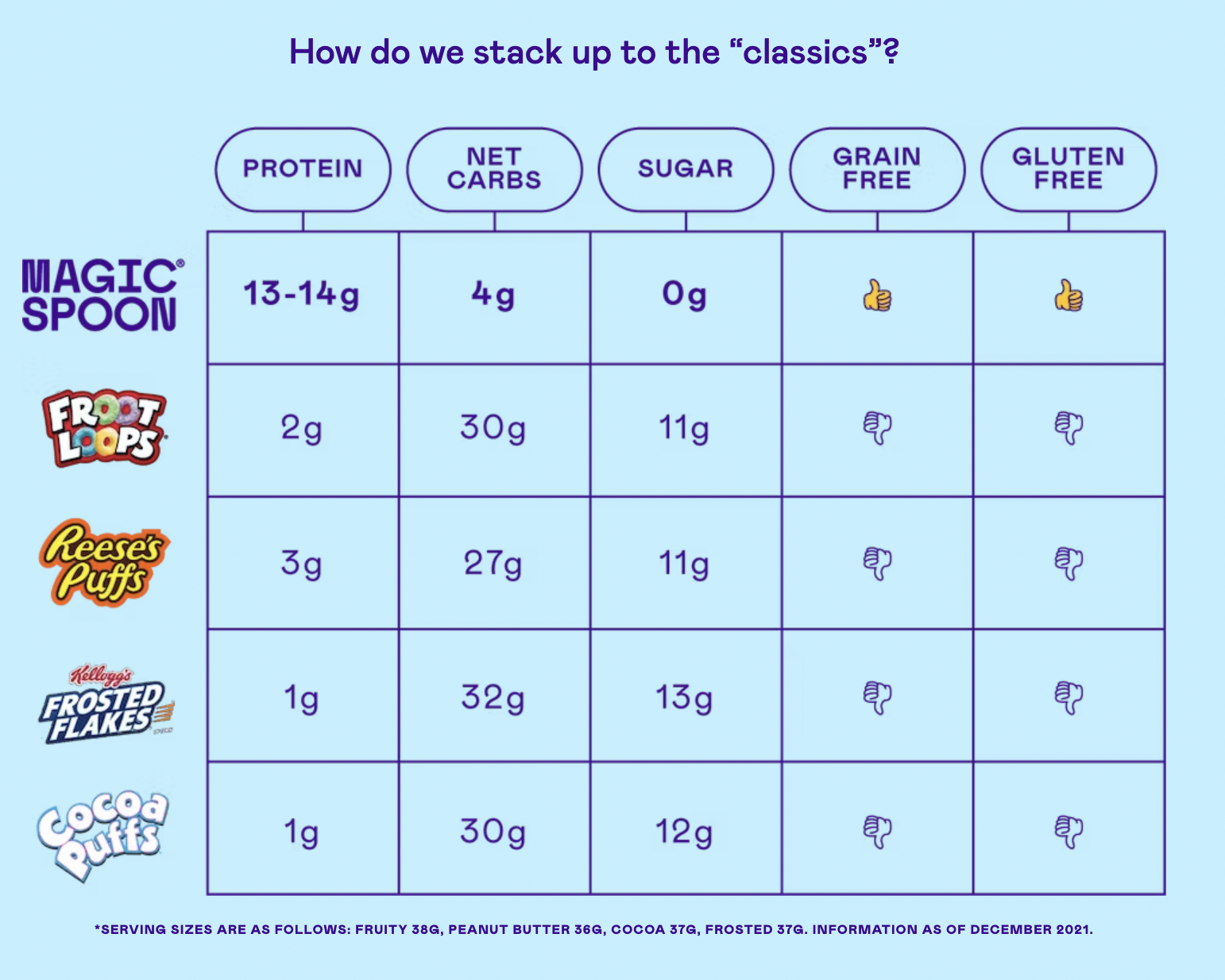
This “better for you” and “better than the alternatives” messaging continues through featured customer reviews.
It’s a constant reminder of why customers should buy Magic Spoon over a brand they’re already comfortable with.
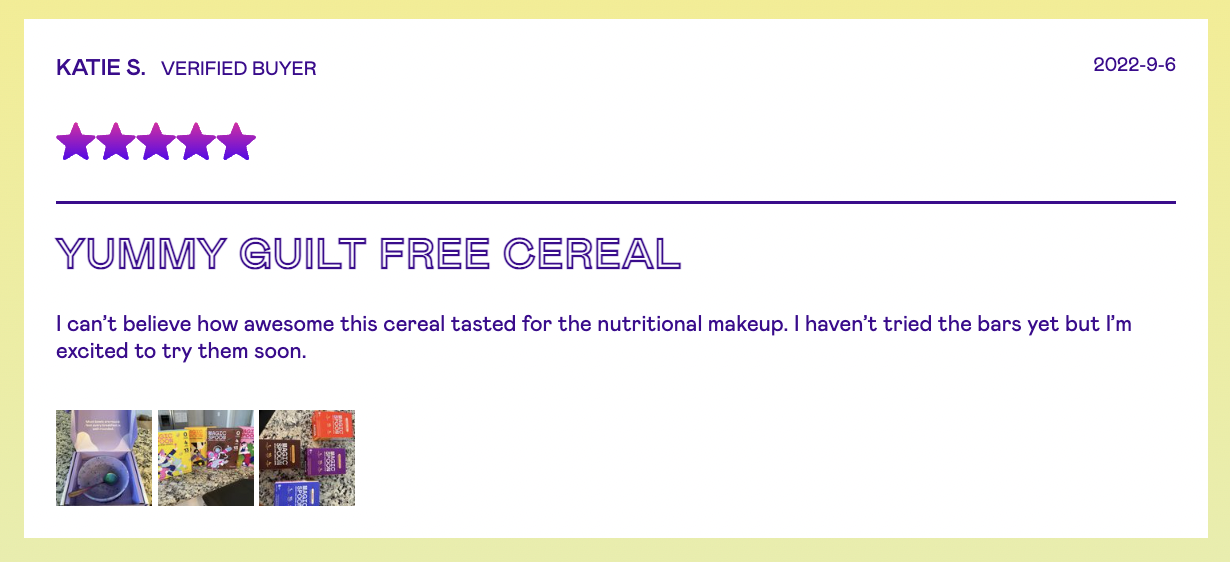
#cta-visual-pb#<cta-title>Customize your store for more conversions<cta-title>Easily create custom product pages, collection pages, and more with Shogun Page Builder.Start building for free
2. House of Wise
Modern consumers don’t always connect with a faceless brand. Millennials, which are the largest purchasing demographic in the US, are a personable generation. They want to see the people behind their favorite CPG brands.
House of Wise does exactly this. Its founder, Amanda Goetz, is an active tweeter who regularly shares what she’s learning as she operates a CPG business.
Followers—all 88K of them—feel like they’re involved in the brand’s journey even if they haven’t bought a product…yet. (Though that’s encouraged with Twitter-exclusive discount codes.)
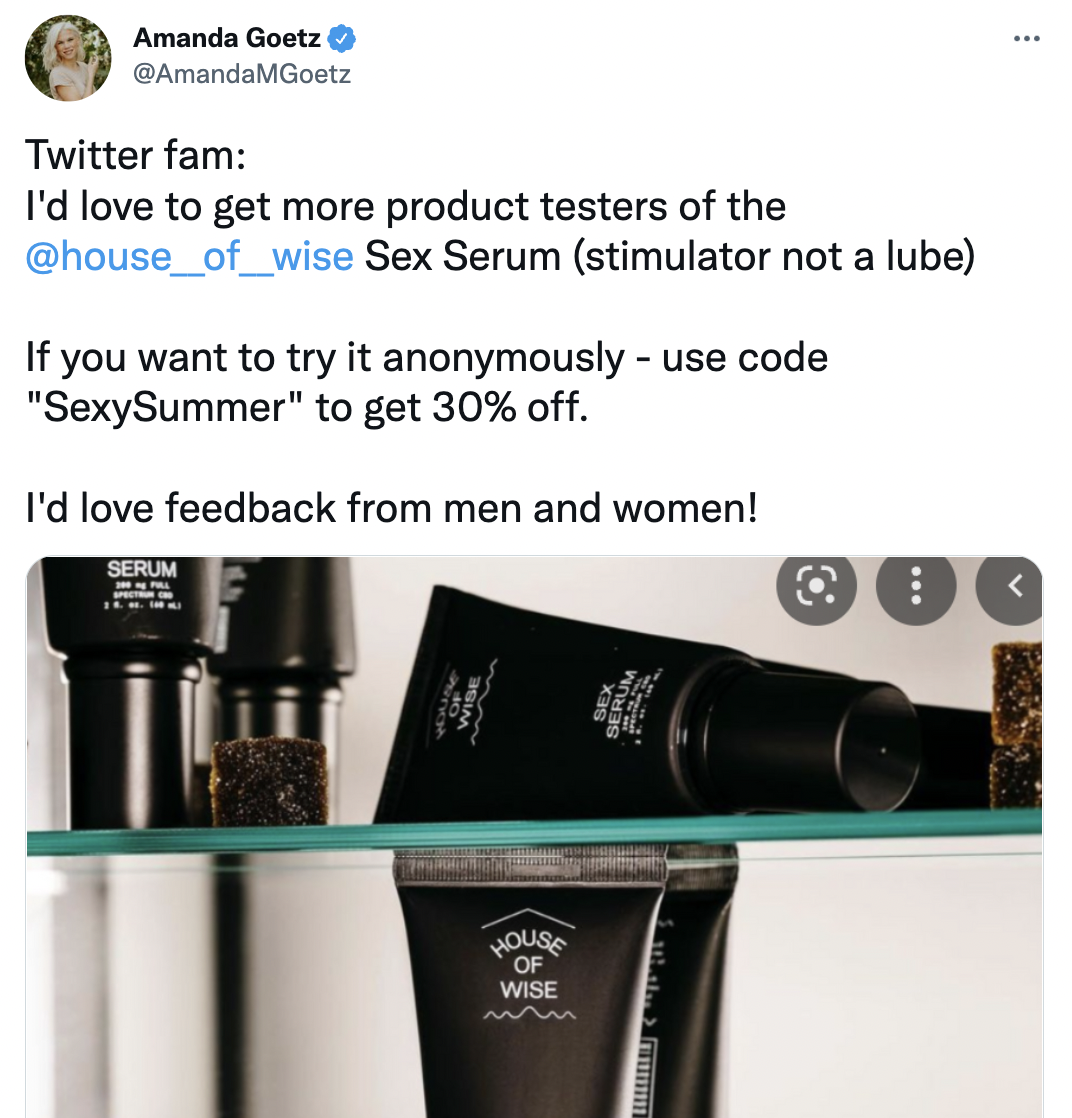
Amanda’s strong presence comes through on House of Wise’s online store. Its About page details why Amanda started the brand, and the social issues she supports—including reducing the stigma that surrounds women who take CBD products.
It goes to show that a CPG brand with an actively social founder who supports issues its customer cares about can be a simple, but effective CPG marketing strategy.
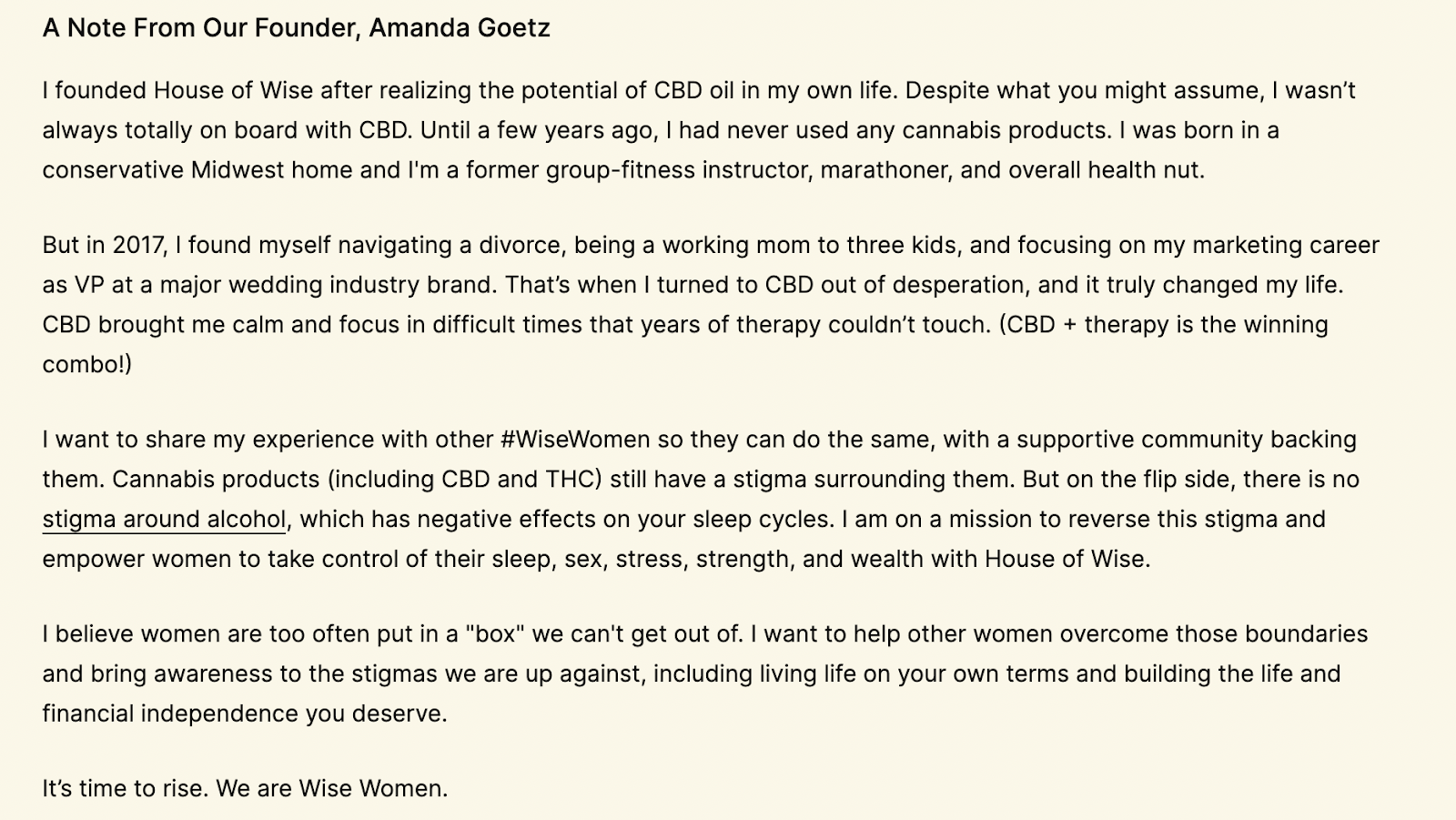
3. Liquid Death
Liquid Death is a case study in how to take an everyday CPG and turn it into a mega-valuable brand.
The retailer sells a product that isn’t in short supply: water. And it just raised another $75 million in funding, bringing its total valuation to an incredible $525 million.
Part of Liquid Death’s success lies in its brand identity. Its product packaging stands out from other clear, often blue-themed sparkling water cans.
The dark, grungy, underground-themed identity proves its marketing team knows exactly who their target customers are.
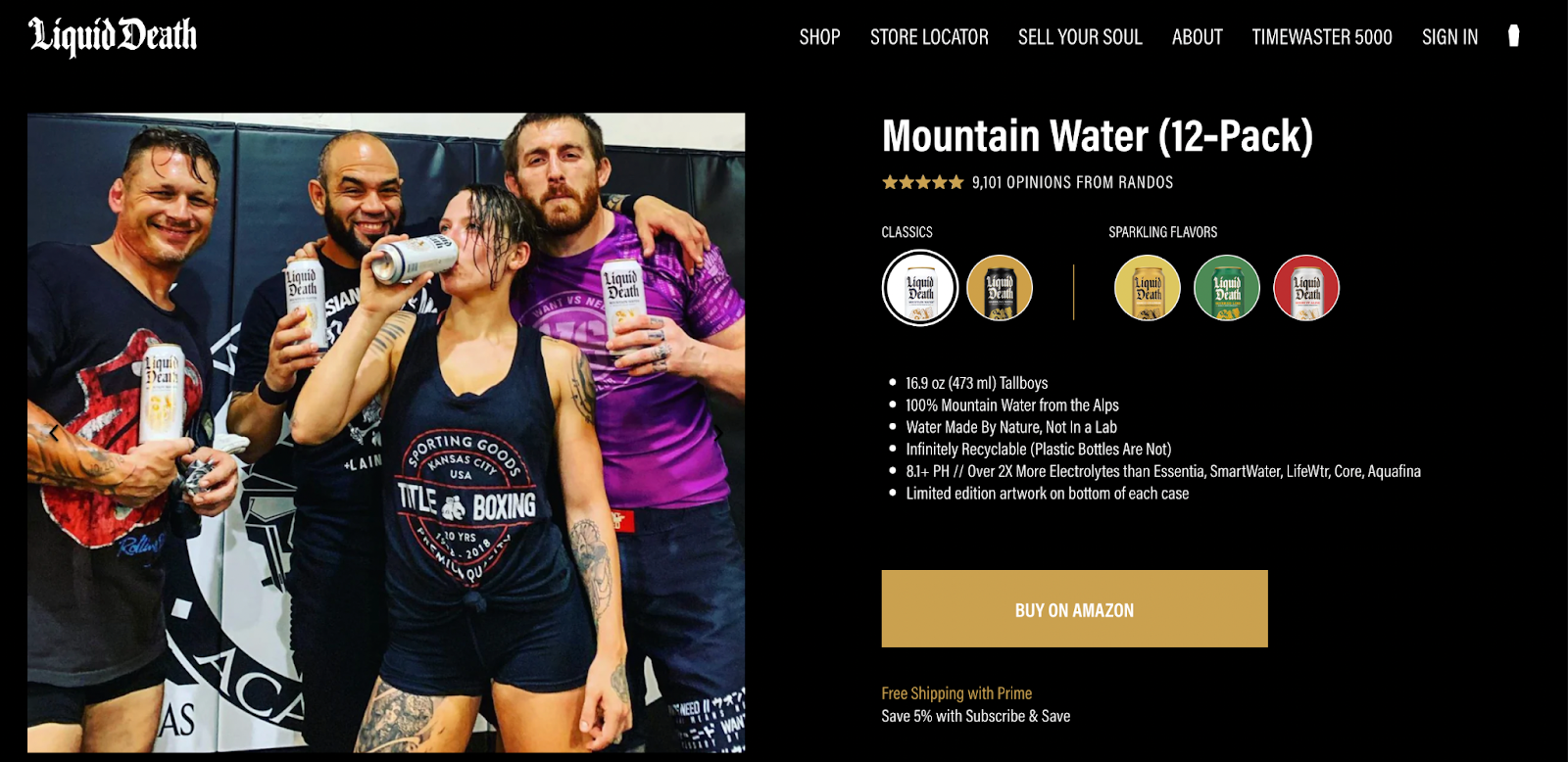
Liquid Death builds a community around its CPG brand with the Country Club program.
Those who spend $50 get an invite to this exclusive club. They’re promised exclusive access to Club-only merchandise, invites to private shows, and limited-edition merchandise before it’s publicly released.
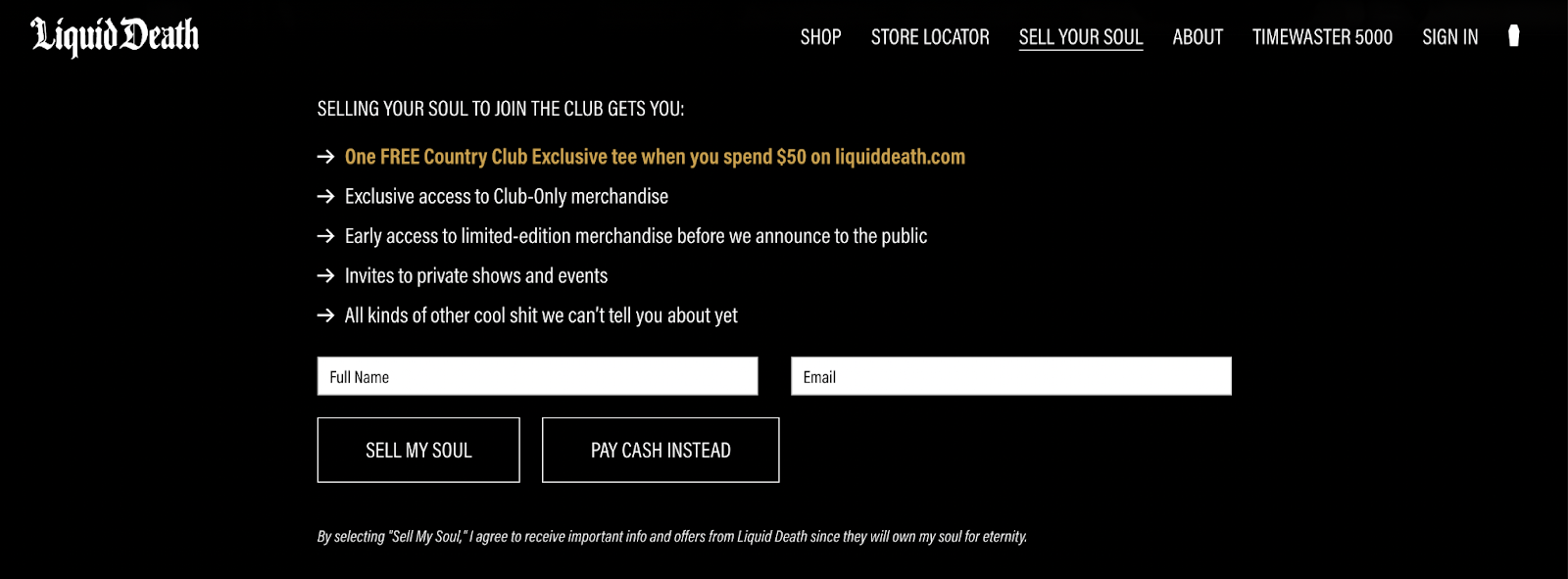
Combine this with its strong values, and it’s clear why Liquid Death has incredible brand loyalty.
A commitment to the “death of plastic” gives the brand personality and helps climate-conscious shoppers buy into its products.
So much so, loyal customers take their attachment to Liquid Death to extreme lengths—even getting tattoos of the brand’s logo to pledge their allegiance.
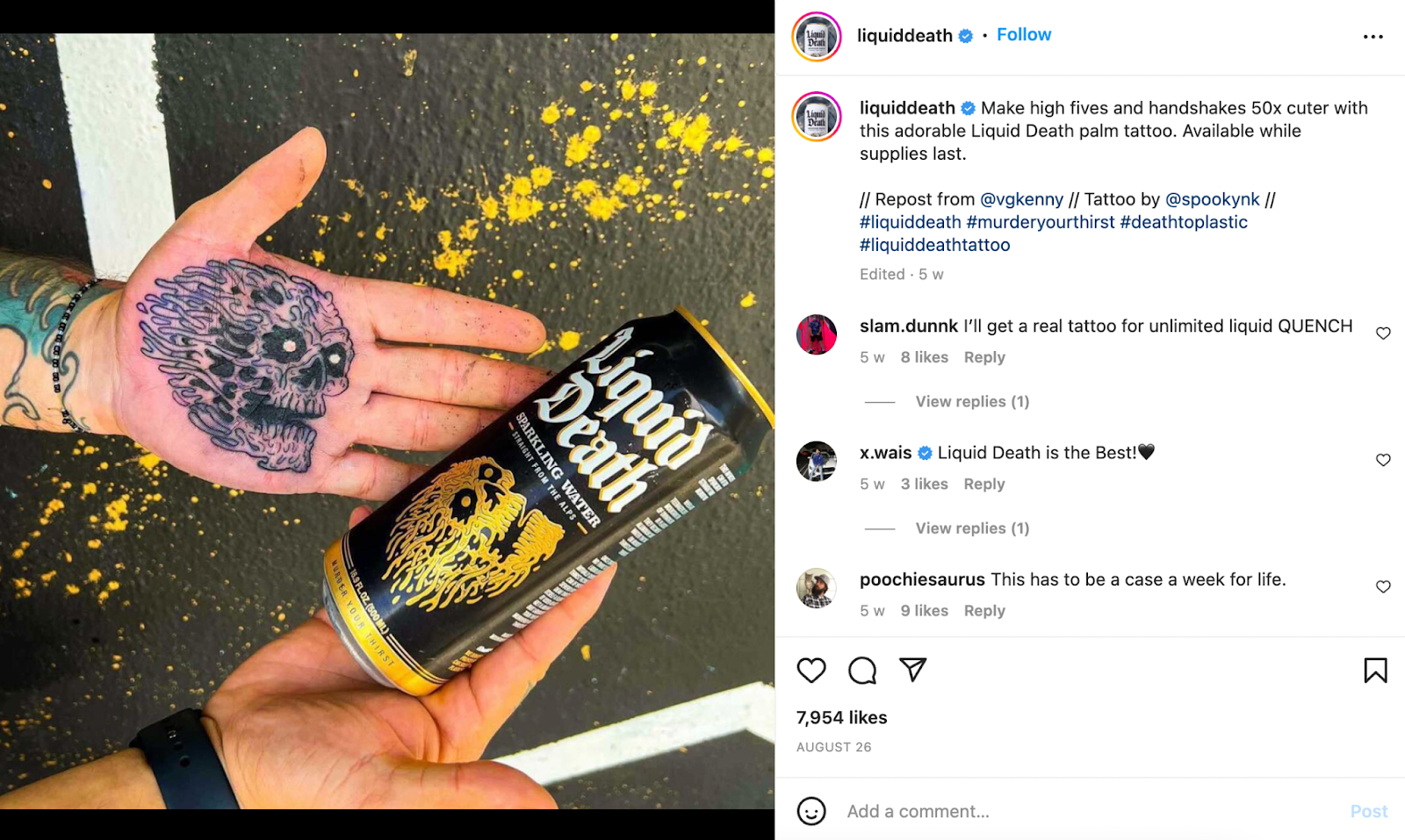
Improve your CPG marketing strategy
Whether you’re launching new products or an established company, a strong brand is one of the most important assets your CPG company can have—aside from great products.
Use these brand marketing techniques to collect consumer insights, connect with customers, and execute a CPG marketing plan you know they’ll engage with.
Most importantly, bake your core values into each campaign. Modern consumers want to connect with CPG brands that share similar values to themselves. It’s a core component of any marketing strategy that’ll set you apart from competitors fighting for your customers’ attention.
#cta-visual-pb#<cta-title>Create the perfect Shopify store<cta-title>Take your store to the next level with Shogun Page Builder.Start building for free

Elise Dopson
Elise Dopson is a freelance writer for B2B commerce and martech companies. When she's not writing, you'll find her in the Peak Freelance community or on Twitter.



